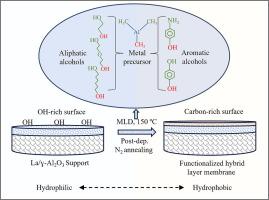当前位置:
X-MOL 学术
›
Appl. Surf. Sci.
›
论文详情
Our official English website, www.x-mol.net, welcomes your
feedback! (Note: you will need to create a separate account there.)
Increasing hydrophobicity of ceramic membranes by post-deposition nitrogen annealing of molecular layer deposition grown hybrid layers
Applied Surface Science ( IF 6.3 ) Pub Date : 2024-11-15 , DOI: 10.1016/j.apsusc.2024.161790 Harpreet Sondhi, Michiel Nijboer, Elissa Makhoul, Arian Nijmeijer, Fred Roozeboom, Mikhael Bechelany, Alexey Kovalgin, Mieke Luiten-Olieman
Applied Surface Science ( IF 6.3 ) Pub Date : 2024-11-15 , DOI: 10.1016/j.apsusc.2024.161790 Harpreet Sondhi, Michiel Nijboer, Elissa Makhoul, Arian Nijmeijer, Fred Roozeboom, Mikhael Bechelany, Alexey Kovalgin, Mieke Luiten-Olieman

|
Molecular layer deposition is increasingly used to functionalize the surface of planar and 3D porous substrates. This study explores functionalized ‘alucone’ hybrid layers grown on ceramic substrates to enhance their surface hydrophobicity. The layers were made from trimethyl-aluminum as a precursor with five different alcohols as a co-reactant: aliphatic (ethane-1,2-diol, 2,2-oxydiethanol, 1,6-hexanediol), and aromatic (4-aminophenol, benzene-1,4-diol). After post-deposition annealing in N2 atmosphere at 250 and 350 °C, the changes in the physical properties and the chemical affinity of the layers were studied and compared to those of the as-deposited hybrid layers. Differential thermal analysis of the hybrid layers showed higher decomposition temperatures for the layers grown from aromatic alcohols than for those grown from aliphatic alcohols. Additionally, Fourier-transform infrared and X-ray photoelectron spectroscopy showed that an increase in annealing temperature decreased the concentrations of surface hydroxyl-groups and caused changes in the carbon-related groups. These results could be correlated to the hydrophobicity of the layers: higher water contact angles (>90°) were measured for annealed samples, compared to those (<90°) of the as-deposited samples grown at 150 °C. These findings confirm that the proposed method of MLD functionalization and post-deposition annealing can be used to tune the surface hydrophobicity of ceramic membranes.
中文翻译:

通过分子层沉积生长的杂化层的沉积后氮退火增加陶瓷膜的疏水性
分子层沉积越来越多地用于平面和 3D 多孔衬底表面的功能化。本研究探索了在陶瓷基板上生长的功能化“明矾酮”杂化层,以增强其表面疏水性。这些层以三甲基铝为前驱体,以五种不同的醇作为共反应物:脂肪族(乙烷-1,2-二醇、2,2-氧二醇、1,6-己二醇)和芳香族(4-氨基苯酚、苯-1,4-二醇)。在 250 °C 和 350 °C 的 N2 气氛中进行沉积后退火后,研究了各层的物理性质和化学亲和力的变化,并与沉积的杂化层进行了比较。杂化层的差热分析表明,芳香醇生长的层的分解温度高于脂肪醇生长的层。此外,傅里叶变换红外和 X 射线光电子能谱表明,退火温度的升高降低了表面羟基的浓度,并导致碳相关基团的变化。这些结果可能与各层的疏水性相关:与在 150 °C 下生长的沉积样品的水接触角 (<90°) 相比,测得退火样品的水接触角 (>90°) 更高。 这些发现证实了所提出的 MLD 功能化和沉积后退火方法可用于调节陶瓷膜的表面疏水性。
更新日期:2024-11-16
中文翻译:

通过分子层沉积生长的杂化层的沉积后氮退火增加陶瓷膜的疏水性
分子层沉积越来越多地用于平面和 3D 多孔衬底表面的功能化。本研究探索了在陶瓷基板上生长的功能化“明矾酮”杂化层,以增强其表面疏水性。这些层以三甲基铝为前驱体,以五种不同的醇作为共反应物:脂肪族(乙烷-1,2-二醇、2,2-氧二醇、1,6-己二醇)和芳香族(4-氨基苯酚、苯-1,4-二醇)。在 250 °C 和 350 °C 的 N2 气氛中进行沉积后退火后,研究了各层的物理性质和化学亲和力的变化,并与沉积的杂化层进行了比较。杂化层的差热分析表明,芳香醇生长的层的分解温度高于脂肪醇生长的层。此外,傅里叶变换红外和 X 射线光电子能谱表明,退火温度的升高降低了表面羟基的浓度,并导致碳相关基团的变化。这些结果可能与各层的疏水性相关:与在 150 °C 下生长的沉积样品的水接触角 (<90°) 相比,测得退火样品的水接触角 (>90°) 更高。 这些发现证实了所提出的 MLD 功能化和沉积后退火方法可用于调节陶瓷膜的表面疏水性。


















































 京公网安备 11010802027423号
京公网安备 11010802027423号